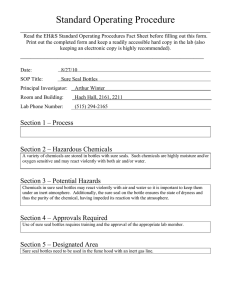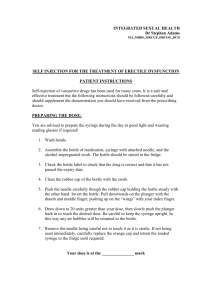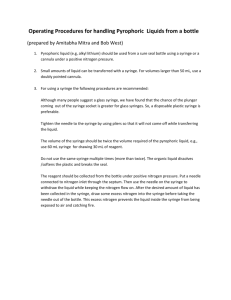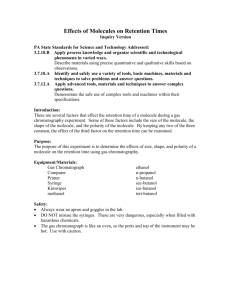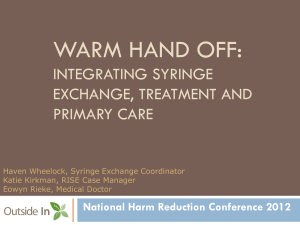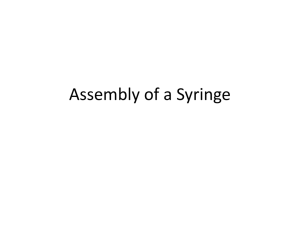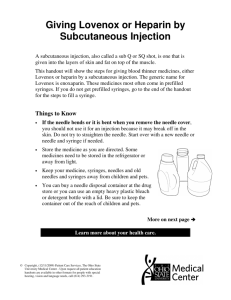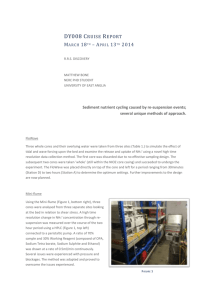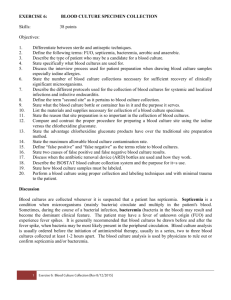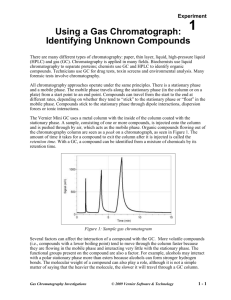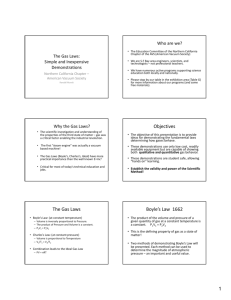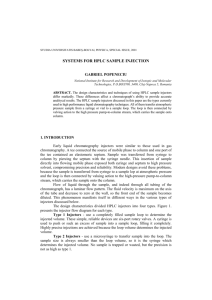Sure Seal Bottles - Environmental Health and Safety at Iowa State
advertisement
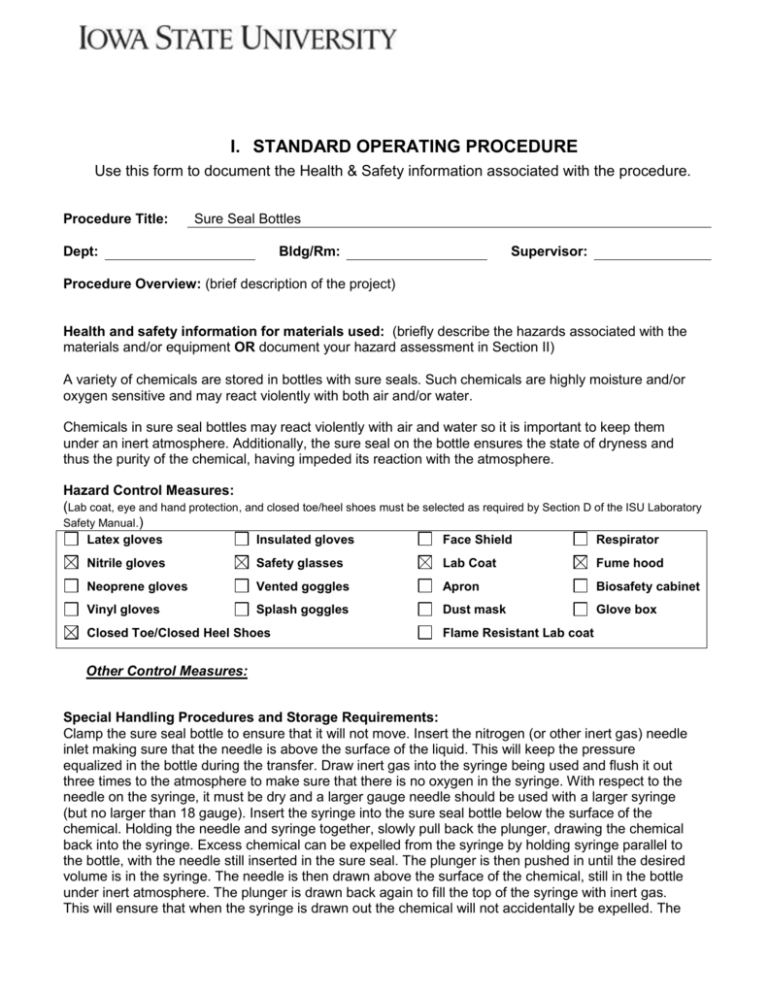
I. STANDARD OPERATING PROCEDURE Use this form to document the Health & Safety information associated with the procedure. Procedure Title: Sure Seal Bottles Dept: Bldg/Rm: Supervisor: Procedure Overview: (brief description of the project) Health and safety information for materials used: (briefly describe the hazards associated with the materials and/or equipment OR document your hazard assessment in Section II) A variety of chemicals are stored in bottles with sure seals. Such chemicals are highly moisture and/or oxygen sensitive and may react violently with both air and/or water. Chemicals in sure seal bottles may react violently with air and water so it is important to keep them under an inert atmosphere. Additionally, the sure seal on the bottle ensures the state of dryness and thus the purity of the chemical, having impeded its reaction with the atmosphere. Hazard Control Measures: (Lab coat, eye and hand protection, and closed toe/heel shoes must be selected as required by Section D of the ISU Laboratory Safety Manual.) Latex gloves Insulated gloves Face Shield Respirator Nitrile gloves Safety glasses Lab Coat Fume hood Neoprene gloves Vented goggles Apron Biosafety cabinet Vinyl gloves Splash goggles Dust mask Glove box Closed Toe/Closed Heel Shoes Flame Resistant Lab coat Other Control Measures: Special Handling Procedures and Storage Requirements: Clamp the sure seal bottle to ensure that it will not move. Insert the nitrogen (or other inert gas) needle inlet making sure that the needle is above the surface of the liquid. This will keep the pressure equalized in the bottle during the transfer. Draw inert gas into the syringe being used and flush it out three times to the atmosphere to make sure that there is no oxygen in the syringe. With respect to the needle on the syringe, it must be dry and a larger gauge needle should be used with a larger syringe (but no larger than 18 gauge). Insert the syringe into the sure seal bottle below the surface of the chemical. Holding the needle and syringe together, slowly pull back the plunger, drawing the chemical back into the syringe. Excess chemical can be expelled from the syringe by holding syringe parallel to the bottle, with the needle still inserted in the sure seal. The plunger is then pushed in until the desired volume is in the syringe. The needle is then drawn above the surface of the chemical, still in the bottle under inert atmosphere. The plunger is drawn back again to fill the top of the syringe with inert gas. This will ensure that when the syringe is drawn out the chemical will not accidentally be expelled. The syringe can then be removed from the bottle. As the nitrogen line is removed from the bottle, the sure seal must be covered with Scotch magic tape to cover the holes created by the needles. This will help insure that the bottle remains under an inert atmosphere. See Figure from UCLA SOP www.chemistry.ucla.edulfiie-storage/.../SOPLiquidReagents.pdf. Waste Disposal Procedures: All reagent bottles should be submitted to EH&S for collection. First Aid Procedures: Consult the chemical specific SDS. All accidents and injuries occurring at work or in the course of employment must be reported to the employee's supervisor as soon as possible (even if no medical attention is required). http://www.ehs.iastate.edu/occupational/accidents-injuries Decontamination: As with any chemical spill, remove all contaminated clothing, wash all contaminated skin with copious amounts of water. Any further steps for decontamination will depend on the chemical. Consult the chemical specific SDS. Spill/Release Containment and Clean Up Procedures: The procedure for spill cleanup will depend on the specific chemical. See Section 11 - Decontamination and consult other SOP's and appropriate lab member for more information on the chemical in question before its use. Using Substances Requiring Special Procedures? No Yes (If Yes; identify authorized personnel, designate a use area and specify specialized safety precautions here. Refer to Section B in the ISU Laboratory Safety Manual for details.) Use of sure seal bottles requires site specific training and the approval from the professor in charge. Written By: Date: Approved By: Date: (PI or Lab Supervisor) II. HAZARD ASSESSMENT Use the hierarchy of controls to document the hazards and the corresponding control measure(s) involved in each step of the procedure. Consider elimination or substitution of hazards, if possible. Engineering Control(s): items used to isolate the hazard from the user (i.e. fume hood, biosafety cabinet). Administrative Control(s): policies/programs to limit the exposure to the hazard (i.e. authorizations, designated areas, time restrictions, training). Required PPE: indicate PPE including specific material requirements if applicable (i.e. flame resistant lab coat, type of respirator or cartridge). Hazard Pyrophoric reagents Engineering Control(s) Fume hood with an inert gas line Administrative Control(s) Site specific training Required PPE lab coat, safety glasses, gloves III. Training Record Use the following table to record the training associated with this Standard Operating Procedure. Print Name Signature Note: Attach to or file with written materials and methods Date
